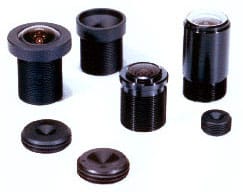High resolution lenses for machine vision — standard and custom lens design
The Difference Between CCD and CMOS Cameras
High Resolution Lenses for machine vision, instrumentation, inspection and vibration-sensitive applications. Standard and custom hi-res lens assemblies.

CCD and CMOS Cameras
An image sensor, housed in a camera, is the device that captures light and kicks off the process of turning the captured image into a digital one. When it comes to cameras used in security settings and the sensors they utilize, there are two basic types:
- CMOS – complementary metal oxide semiconductor models
- CCD – charge coupled device styles
Whether you choose a CCD or a CMOS camera will depend almost entirely upon the camera’s use.
How the technologies vary
CMOS camera sensors perform on an individual pixel platform which means each has its own charge-to-voltage conversion. The sensor can also perform noise amplification and noise correction during operation. CMOS cameras do not capture images at as high a quality as CCDs because the ability to capture light is reduced.
A CCD camera utilizes a technology platform in which each individual pixel’s charge is transferred through an output node, and following that it will be converted into an electrical signal. Once the signal has been converted it is buffered and passed through as an analog signal. A CCD can typically capture higher quality images because the pixels are devoted to light capture.
The costs to manufacture and purchase a CCD or a CMOS camera are similar due to advances in technology. The CCD sensors are prized for image quality and low light operations while the CMOS sensors are ideal for devices that require speed and low power consumption, sometimes at the cost of lower image quality.
How to choose which technology to use When it comes to performance, the camera technologies are almost identical. When it comes to power requirements, a CMOS sensor camera is more ideal especially if you will be using cameras that operate on batteries.
There are areas in which a CCD camera excels and those are in night vision image capture and this is necessary for security cameras that will be used at night or in low light settings. In some of the technologies, a CMOS camera in low or no light settings are almost “blind.” CCD cameras excel in the low light and in conjunction with infrared lighting.
Image quality in either of the technologies are slowly getting closer in scope. Currently the CCD camera captures images at a higher quality because of its sensors exhibiting fewer image noises than does a CMOS sensor.
CMOS sensors are ideal for those situations in which there is a built in web-server and in which it can communicate over an IP protocol and in higher light situations. They are affordable and perfect for indoor use.
A CCD sensor is best for outdoor use in situations that may require image capture in low light settings.
Universe Optics is a manufacturer of standard and custom CCD/CMOS lens assemblies for board and miniature camera applications including digital photography, video conferencing, surveillance, barcode scanning, machine vision and medical systems.